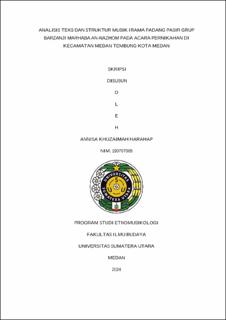Analisis Teks dan Struktur Musik Irama Padang Pasir Grup Barzanji Marhaba An-Nazhom pada Acara Pernikahan di Kecamatan Medan Tembung Kota Medan
Analysis of the Text and Structure of the Desert Rhythm Music of the Barzanji Marhaba An-Nazhom Group at a Wedding Event in Medan Tembung District, Medan City

Date
2024Author
Harahap, Annisa Khuzaimah
Advisor(s)
Fadlin
Ginting, Yoe Anto
Metadata
Show full item recordAbstract
This article discusses the meaning of text and the structure of rhythmic music in the sand at weddings in Medan Tembung sub-district, Medan city. The Barzanji Marhaba An-
Nazhom group is an orchestra group that focuses on performing and preserving desert
rhythm music in the city of Medan. The Barzanji Marhaba An-Nazhom group was formed
by Ustad Soleh Rambe and currently has six members. There are two songs that are often sung by the Barzanji Marhaba An-Nazhom orchestra group, especially at weddings, namely "Kasih Sayang Bunda" and "O Mawar". This research aims to analyze the meaning
of the text and musical structure of the two songs performed by the Barzanji Marhaba An-
Nazhom group at a wedding event. Explaining these two things, the author uses the field
work and desk work methods proposed by Bruno Netll. The theory used to answer the
problem formulation in this paper is the semiotic theory pioneered by Roland Barthes
regarding the meaning of denotation and connotation and the weighted scale method
proposed by William P. Malm. The results of the research reveal that the two songs “Kasih Sayang Bunda” and “O Mawar” both want to convey a sense of admiration for women. A woman who is able to become a mother who sacrifices for her child's future.
Collections
- Undergraduate Theses [308]
